A thorough guide to making authentic Chinese steamed pork buns with chive, from scratch, including step-by-step photos and tips to help you succeed. The buns will come out extra juicy, fluffy, and tender – even better than those you get at a restaurant.

Steamed pork and chive buns are a Northern Chinese classic and they have a special place in my heart. The fluffy yeast buns are stuffed with a tender, juicy filling of pork and Chinese chive, creating an intense, savory taste that is ultra satisfying and comforting.
In China, you can easily get these buns fresh from a street vendor, school, office cafeteria, or quick-serve restaurant. It’s quite common to see commuters rush into morning trains holding a bag of steamy hot pork buns and eating them on the go. They are a cheap, quick snack that’s suitable for any time of day.
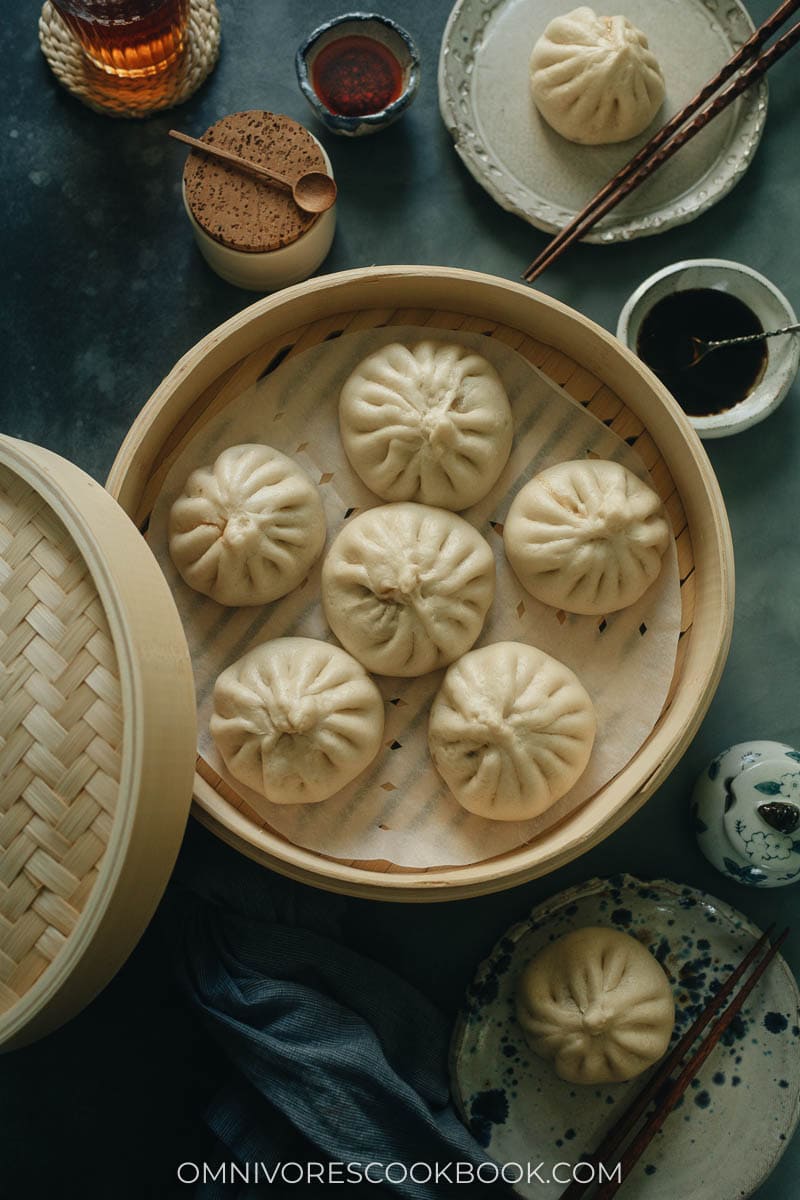
What is Chinese chive
Chinese chive, or Jiu Cai (韭菜), is also called garlic chive. It has flat leaves and tender tubes, with a robust taste of garlic and green onion.
Because of its strong taste, my mom doesn’t like to make steamed pork buns with chive at home. She thinks the Chinese chive is too stinky!
It is true – when you combine green onion and garlic into one plant, the result somehow intensifies and creates a doubly pungent taste. Although the buns are extremely delicious when you eat them, your house may still be vampire-proof for a few hours after you wash the dishes.
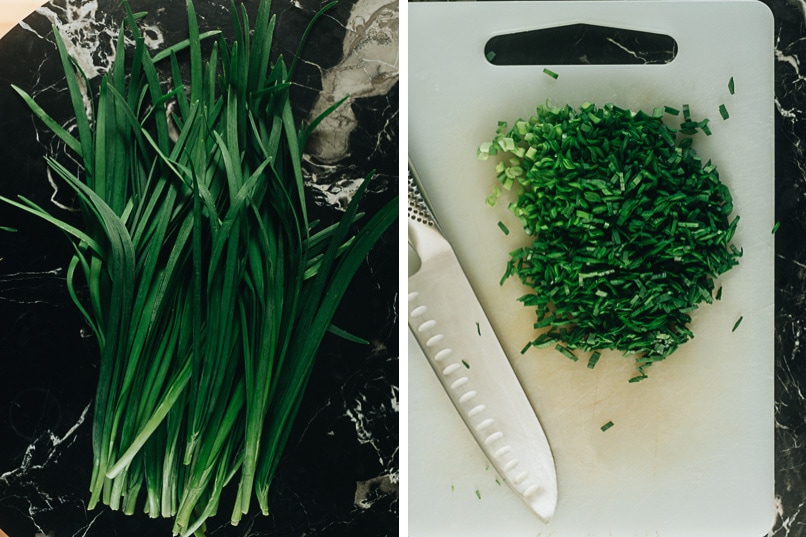
Why this recipe
My dad and I LOVE the pork and chive filling. So once in a while when my mom was in a good mood, we’d get to eat the homemade buns. It’s ten times better than the street food version because the buns are extra fluffy with a thinner skin, and the filling is bigger and juicier.
I really love this recipe because:
- You can use a stand mixer to knead the dough, which makes the process much easier and consistent
- The ginger water method adds more liquid into the filling, making it extra juicy. If you bite into the freshly steamed buns, you can see a small pool of juice on the bottom of the buns.
- The filling is extra flavorful and tender.
- The skin is fluffy and soft.
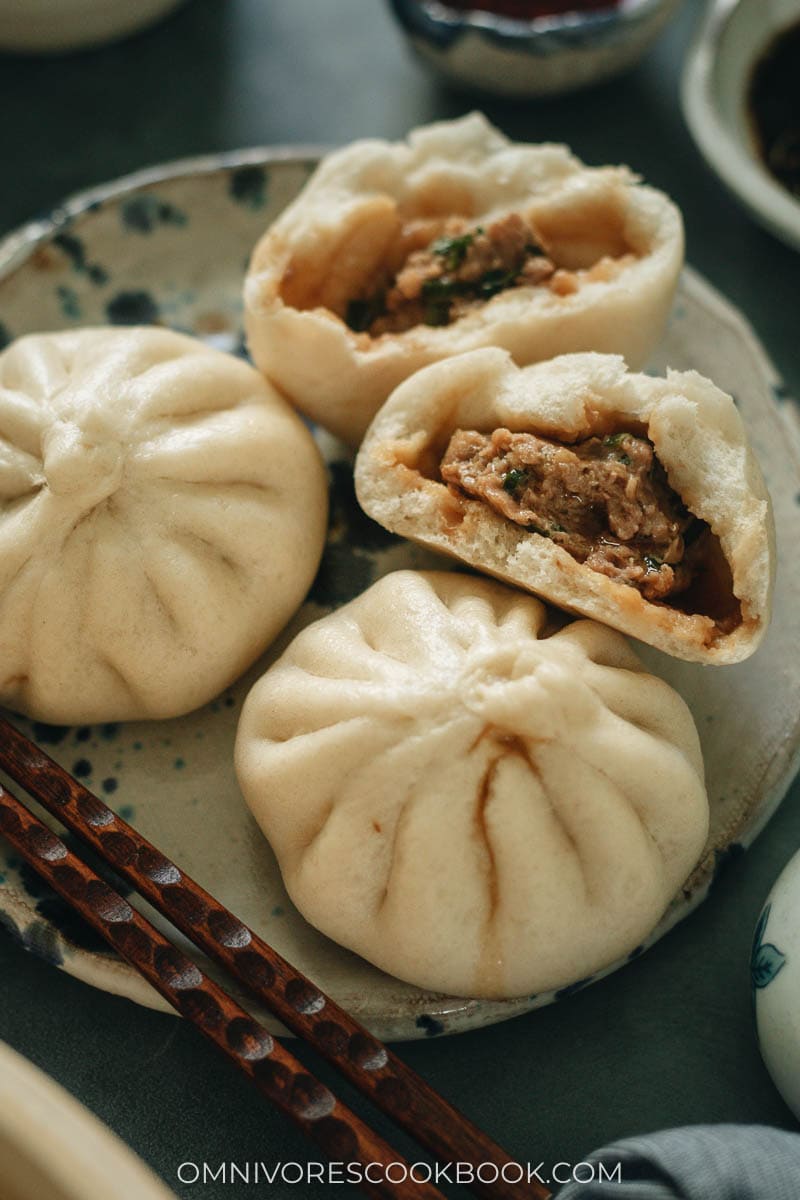
Essential tools
Here are a few things you’ll need to make the steamed pork buns or any steamed yeast buns:
Steamer
It’s totally OK to use a regular stainless steel steamer. In this case, you will need a towel to pad the steamer and the lid. It helps catch the condensation formed during the steaming process, which causes the buns to collapse if not absorbed.
If you want a more perfect result, purchase a set of bamboo steamers. They will help vent the steam better without forming condensation. You’ll also have two tiers to work with, which means you can cook more buns at a time.
Steamer liner
A steamer liner is a piece of perforated parchment paper that’s cut to the size of the steamer. You should use it to line the steamer to prevent the buns from sticking.
Of course, you can cut parchment paper to create the liners yourself. Make sure to cut small holes throughout so the steam will go through. I found that the cutting takes quite a bit of time and effort. If you plan to steam food more often, I recommend buying a pack of liners instead.
For a more environmentally friendly method, you can also wet a few layers of cheesecloth and squeeze out as much water as possible and use that as your liner. It’s the method my mom always uses. You should use dish soap to thoroughly clean the cheesecloth and air dry it after each use.
Small rolling pin
You should always use a smaller, shorter rolling pin for making all Chinese buns and dumplings. It’s lighter and easier to handle as you roll out small objects such as bun wrappers.
Making steamed pork buns with chive at home
Making steamed buns from scratch might sound intimidating, but the process is actually not as bad as it looks.
The dough
The dough contains a few simple ingredients – warm water, sugar, yeast and flour.
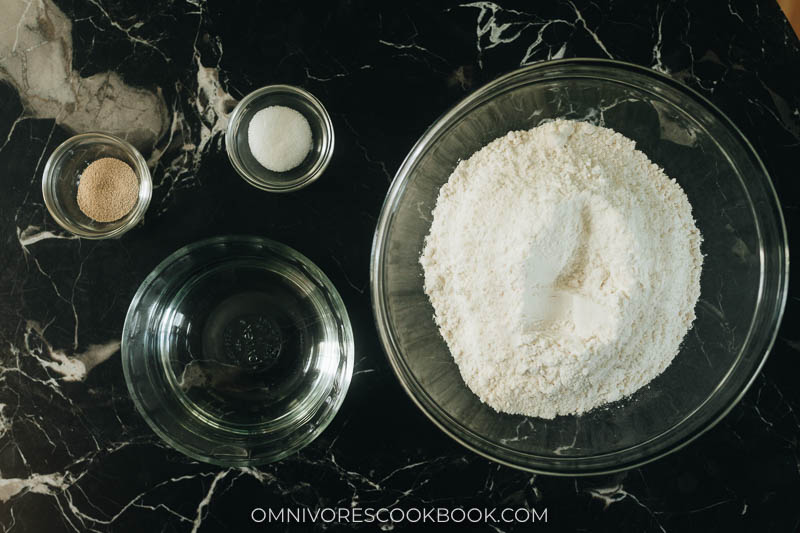
Although we usually hand mix and knead the dough in China, I’ve found that it’s totally OK to knead the dough in a stand mixer.
All you need to do is:
- Add the active dry yeast into warm water
- Wait until the yeast is activated and bubbly
- Mix the ingredients
- Knead until the dough is smooth and elastic
- Cover to rest until the dough doubles in size
NOTE:
Depending on your room temperature and humidity, the resting time can vary a lot. You should check on the dough every 15 minutes after the first 30 minutes have passed, to prevent over-proofing.
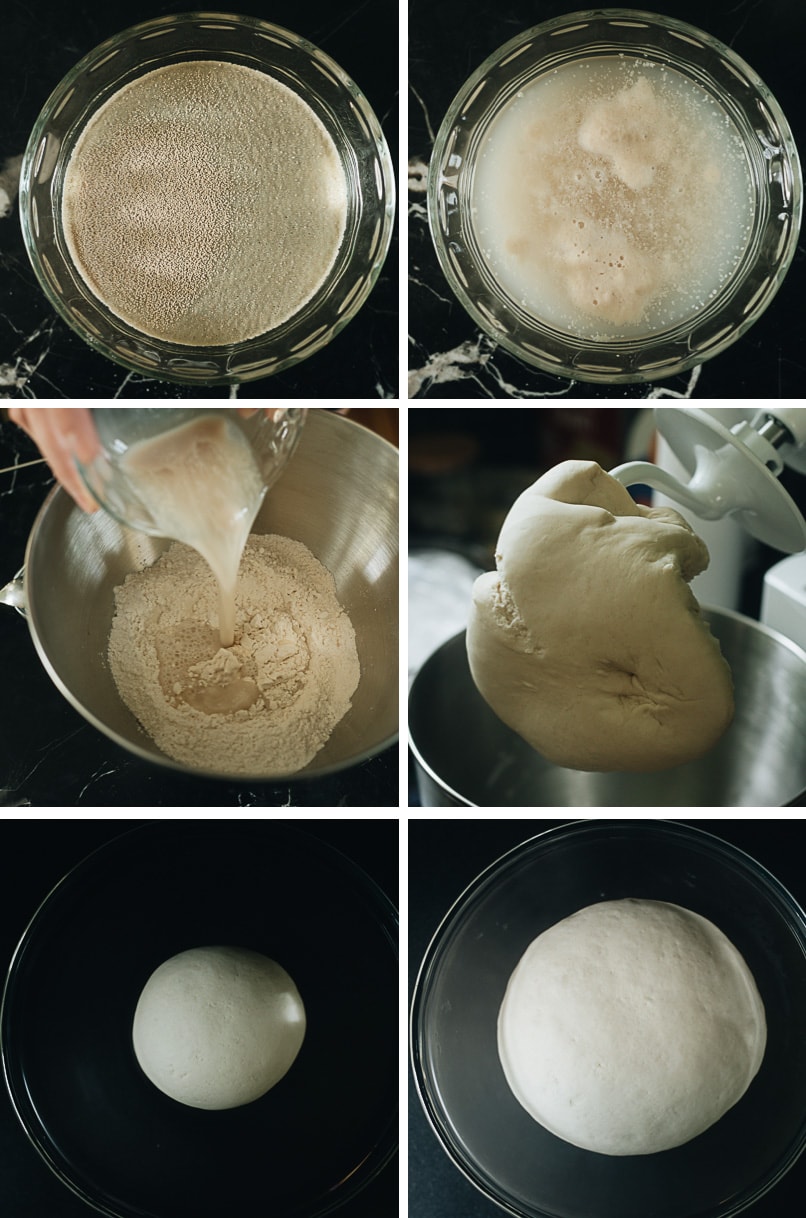
The filling
The filling is made with ground pork, chive, ginger water, and a few seasonings.
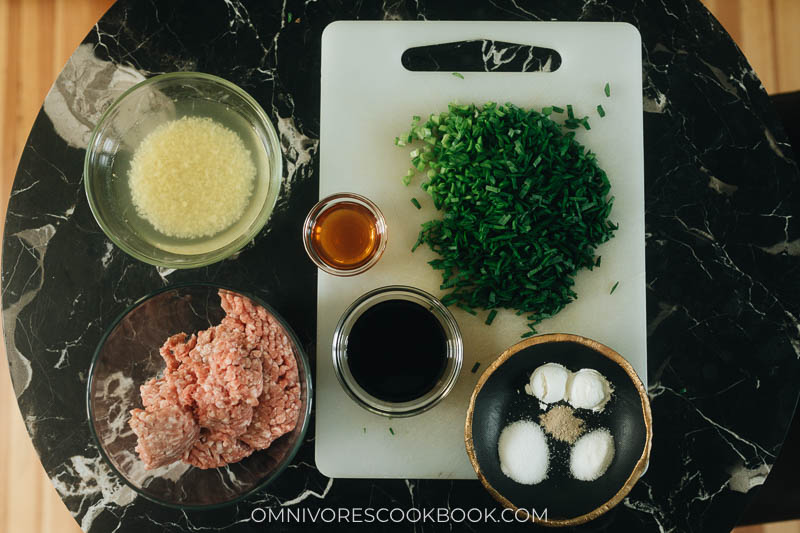
To make the filling:
- Mix the pork, ginger water, and seasonings
- Beat in one direction until the pork is sticky and springy
- Add the Chinese chives
- Mix again to combine

NOTES
- For the ginger water, you can choose to add all the minced ginger into the filling or strain and discard the pieces. I like a gingery taste so I added it into my buns. But I do think the buns without ginger have a more balanced flavor.
- It’s very important to beat the pork thoroughly until it feels very sticky. This step will allow the pork to absorb all the liquid, making the filling very tender and juicy. It also helps the filling to hold together.
Wrap the buns
Once the filling and the dough are ready, you can wrap the buns.
- Knead the dough again so it returns to its original size
- Divide the dough evenly
- Always cover the dough you’re not working on to prevent drying out
- Form the dough piece into a round shape
- Roll it out so the center is slightly thicker than the edges
- Add the filling
- Make the pleats
- Twist and seal the bun
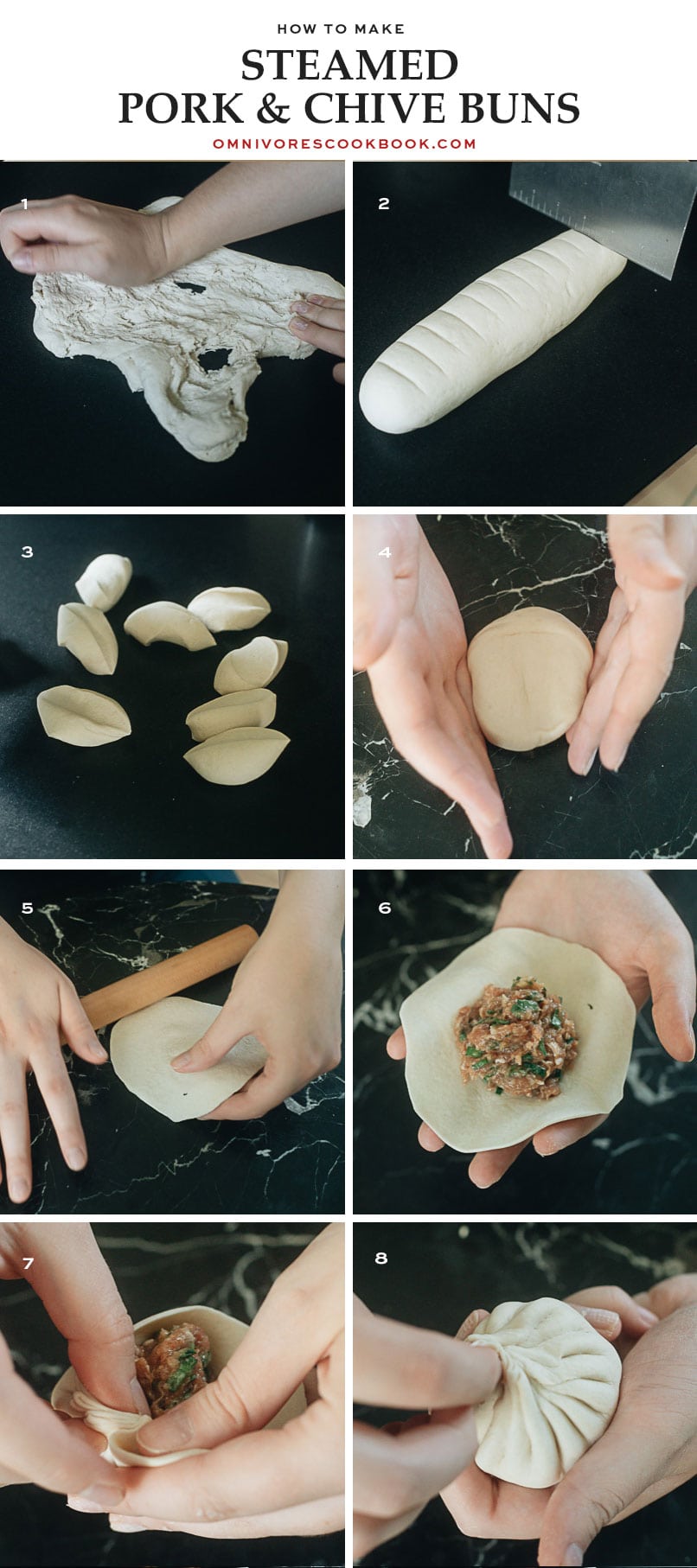
How to make pleats video: I haven’t gotten a chance to make a video for this recipe. If you’re not sure how the wrapping works, I suggest you check out my previous steamed kimchi pork bun video for a better understanding.
Rest and cook the buns
- Once you wrap the buns, you need to let them rest for 15 minutes before cooking.
- Once their size has slightly increased, you can start steaming
- Calculate the steaming time starting from the point that you see the steam coming out
- Let the buns rest a few more minutes before uncovering the lid. This step allows the pressure in the steamer to drop gradually, so the buns won’t shrink as soon as you open the lid.
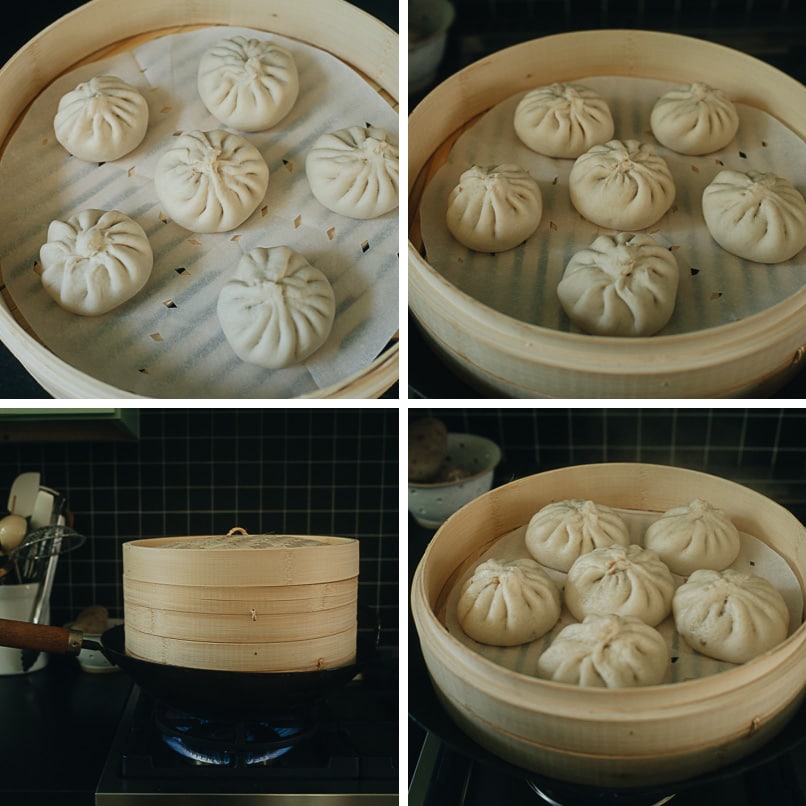
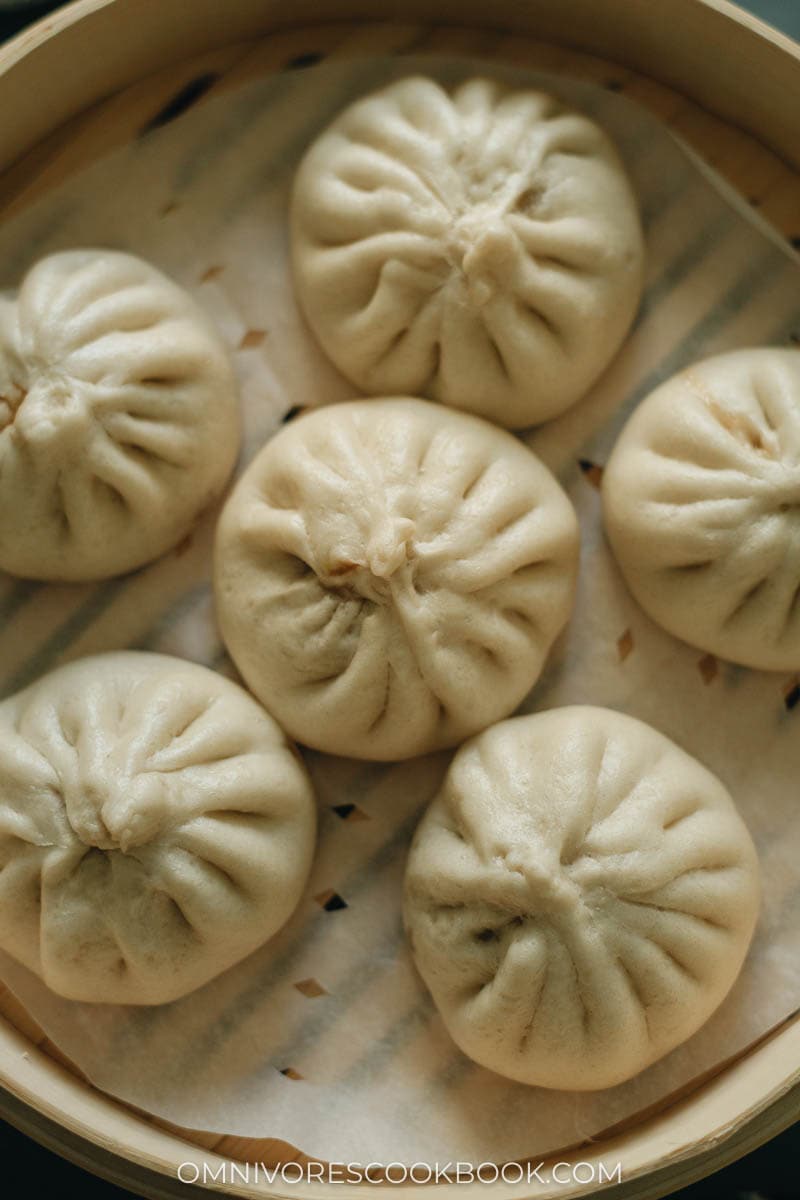
Workflow & how to make a double batch
It’s always easier if you have an extra pair of hands when it comes to wrapping the buns. Once they’re wrapped, you’ll want to rest them for just the right amount of time before cooking. Rest them too little, and the buns won’t be as fluffy. Rest them too much, and the air bubbles in the wrapper might become too big and make the buns ugly or even cause them to collapse.
If you are working on the buns by yourself, I recommend cooking them one batch (6 buns) at a time for the best results. In the recipe below, I also include how you should measure the resting time if you cook all the buns at the same time.
Make a double batch
The process of making a double batch can be a little tricky, since the longer you work on the buns, the further the rest of the dough will rise.
I recommend putting half of the dough in the refrigerator after the first rise, to prevent the dough from overproofing.
While you rest the second batch, you might need to slightly adjust the resting time. Because the dough will be cold from the fridge and it needs a bit of time to return to room temperature.
How to store and reheat the buns
There’s no great way to store the uncooked buns. Once you start making the dough, every step affects how the dough rises and it’s hard to control it before cooking.
That’s why I always recommend that you only store the cooked buns. Granted, the buns will lose some of their juiciness, but the result will be much more consistent and is overall better than storing the uncooked buns.
To reheat the buns, the best way is to use a steamer, just like you’d cook the raw buns. If you want a quick reheat for the refrigerated buns, a microwave works, too. Be aware, though, that the skin might become a bit tough if you reheat the bun for too long in a microwave.
If you only make 12 buns, I highly doubt if you will have any leftovers! I can easily eat half a dozen in one sitting and finish up the rest when I get that midnight salty food craving 🙂
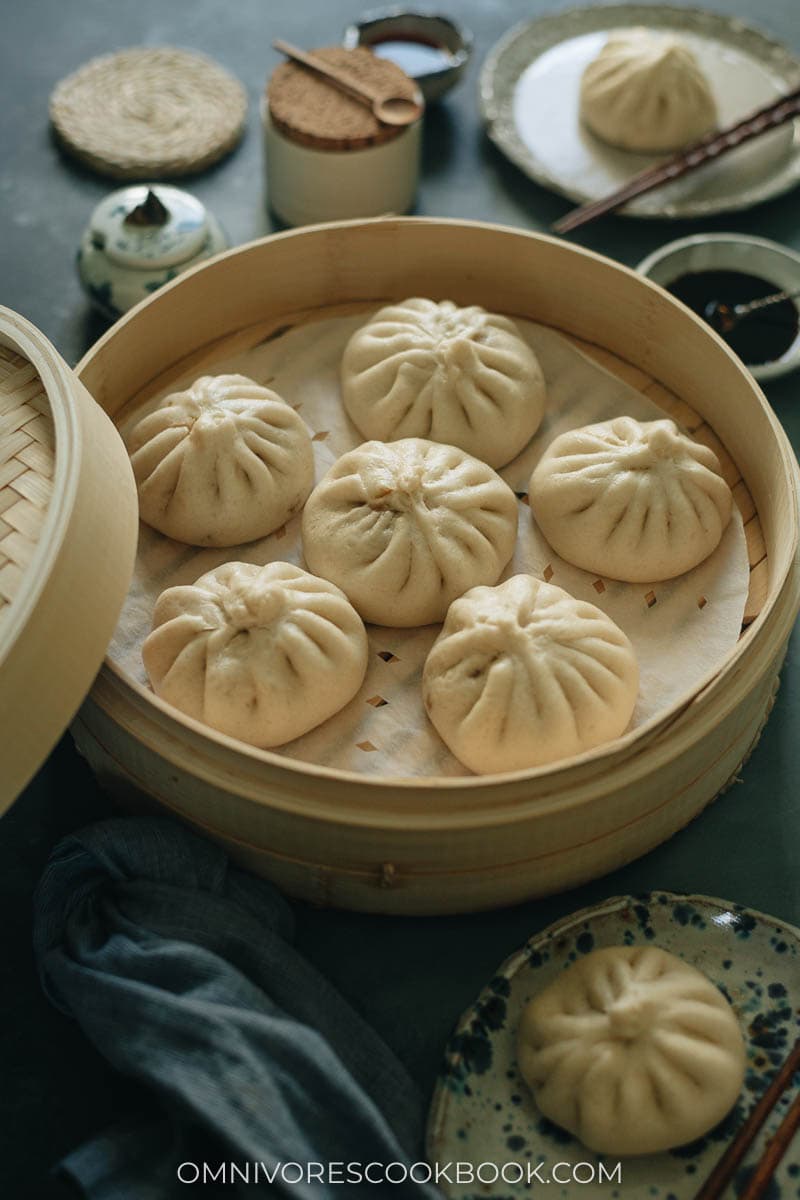
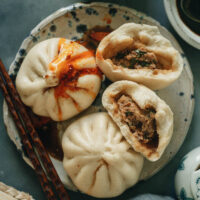
Steamed Pork Buns with Chive (猪肉韭菜包子)
Ingredients
Ginger Water
- 120 ml (1/2 cup) boiling water
- 2 ” (5 cm) ginger , minced
Dough
- 150 ml (1/2 cup + 2 tablespoons) warm water
- 4 g (1 teaspoon) sugar
- 3 g (1 teaspoon) active dry yeast
- 300 g (2 cups) all-purpose flour
Filling
- 300 g (11 oz) ground pork
- 1 tablespoon oyster sauce
- 1 tablespoon light soy sauce (or regular soy sauce)
- 1 teaspoon dark soy sauce
- 1/2 tablespoon Shaoxing wine (or dry sherry)
- 2 teaspoons cornstarch
- 1 teaspoon salt
- 1/2 teaspoon sugar
- 1/8 teaspoon ground white pepper
- 1 tablespoon toasted sesame oil
- 8 stalks Chinese chives , sliced into 1/4” (0.5 cm) pieces
Dipping sauce
- Chinkiang vinegar
- Soy sauce (Optional)
- Homemade chili oil (Optional)
Instructions
Make ginger water
- Add the minced ginger to a small bowl and pour the boiling water over it. Let cool completely. Then drain off the ginger using a fine mesh strainer and discard it. (*Footnote 1)
Mix the dough & 1st rise
- Heat the water in the microwave or over the stovetop until warm to the touch, about 110°F (43°C).
- Add the sugar to the water and stir to dissolve.
- Add the yeast. Let sit for 5 minutes or until the yeast is bubbling up.
- Option 1 – use a stand mixer: Add the flour into the mixing bowl and pour the water into the center. Mix on low with the dough hook until a shaggy dough forms. Keep mixing and gradually turn the speed to 3, until the dough is smooth and elastic, 15 minutes or so. After 8 minutes, if the dough does not come together, use your hands to help gather the flour on the bottom. Keep mixing for another 3 to 5 minutes. If there’s still flour left, slowly add more water, 1 teaspoon at a time, until a smooth dough forms. The dough should be slightly tough to touch and feeling a bit tacky, but doesn’t stick to your hands. Shape the dough a few more times with your hands so it forms a round ball.
- Option 2 – knead with your hands: Add the water into a big mixing bowl. Slowly drizzle the water with yeast into the flour while stirring with chopsticks in a circular motion. After all the water is added, mix until a shaggy dough forms. Press the dough together using your hands, then transfer the dough and any flour left onto a clean working surface. Knead until a smooth and elastic ball is formed, about 15 to 18 minutes. The dough should be slightly tough to touch and feel a bit tacky, but shouldn’t stick to your hands.
- Cover the mixing bowl with plastic wrap. Rest until the size doubles, about 1 hour (45 to 90 minutes depending on heat and humidity). (*Footnote 2)
Prepare the filling
- While the dough is rising, make the filling. Add the pork into a medium-sized bowl and pour in the strained ginger water.
- Add the rest of the filling ingredients except for the sesame oil and Chinese chive.
- Beat everything together in one circular direction by hand or with a wooden spatula, until all the liquid is absorbed and the pork is streaky, 5 minutes or so.
- Add the sesame oil and Chinese chive. Mix for another minute.
- Cover with plastic wrap and transfer into the refrigerator until the dough is ready.
Prepare the steamer
- Use a piece of steamer paper to line the steamer. If you don’t have steamer paper, you can cut a piece of parchment paper into a round shape, then cut a few holes through the paper.
- If you plan to use a bamboo steamer, fill a large tray (that can fit the steamer) with 1” (2.5 cm) water. Soak the bottom of the steamer before cooking. This will prevent the steamer from scorching.
- If you use a stainless steel steamer, prepare a clean kitchen towel and use it between the lid and the steamer. This will prevent the condensation from dripping onto the buns and affecting their rise.
Form the buns & 2nd rise
- Once the dough has doubled in size, punch it down with your fist. Knead with your hands until it returns to its original size, about 10 minutes.
- Divide the dough into 2 even pieces. Transfer one piece back to the bowl and cover it with plastic wrap to prevent it from drying out.
- Work on the other piece by rolling the dough into a long log. Cut the log into 6 even pieces, or 38 g per piece using a scale.
- Cover the dough pieces with plastic wrap and work on one piece of dough at a time – place the dough piece cut side down. Use your palms to round the sides into a round shape.
- Press the dough into a round disk using your palm. Start to roll it out with a rolling pin. If you’re not familiar with the process, roll the dough a few times, rotate it and roll the short ends again. After a few times, start to focus on rolling out the sides so the center is thicker and the edges are thin. If you’re skillful, use one hand to rotate the dough with the other hand rolling out one end until forming a round wrapper. Once done, the wrapper should be about 4.5” (11 cm) wide, with a slightly thick center and thin edges.
- Place about 2 tablespoons of filling (or as much you can wrap) in the center of the wrapper. Make pleats by pinching a piece of the edge to itself, then folding the adjacent edge over your finger holding the pinch, then press the folded edges together. Rotate and repeat the process until all the edges are pleated. Then spin and pinch the center together to seal the bun.
- Once done, place the buns into the lined steamer, then cover them with plastic wrap.
- Repeat the process until you fill the steamer, making sure you leave at least 1” (2.5 cm) between the buns.
- Place the stamer over a large pot filled with cool water. Let rise for 15 minutes, or until the size becomes a bit larger.
- If using a regular steamer, you’ll probably need to cook in 2 batches because it won’t fit in all the buns. You should cook the first batch immediately after resting, while you work on the second batch.
- If you are using a stacked bamboo steamer, you can cook all the buns at the same time. In this case, start the timer after you finish wrapping the first batch. And only let it rise for 10 minutes. Make sure the 1st batch is on the bottom and the second batch stacked on top.
Cook the buns
- Once the buns have risen, turn to high heat. Keep an eye on the steamer. Once steam starts to come out from the side, keep cooking over high heat for 15 minutes.
- Once done, turn off the heat and let sit for 2 minutes before removing the lid.
Serve
- Serve hot with vinegar as a dipping sauce. If you want to make the dipping sauce saltier, you can add a splash of soy sauce. You can also add some chili oil to the dipping sauce if you like a spicy taste.
- Store the leftover buns in an airtight container in the fridge for 3 days or in the freezer for 1 month.
- You can reheat the refrigerated buns in the microwave. For best results with frozen buns, heat them up in the steamer until the buns are warmed throughout.
Notes
- It’s totally OK to reserve the minced ginger and add it to the bun filling if you like the ginger taste and do not mind the texture being a bit less smooth.
- Resting time can vary a lot depending on the temperature and humidity of your room. If your room is hot and humid, the dough might rise very quickly. I prefer to rest the dough in a room with the AC on (if it’s hot), so the dough doesn’t become bubbly too fast. In winter, you can rest the dough in a sunny spot to help it rise faster.
Nutrition
More Chinese Buns and Dumplings
- Sheng Jian Bao (生煎包, Shanghai Pan-Fried Pork Buns)
- Addictive Kimchi Pork Steamed Buns
- Soup Dumplings (小笼包, Xiao Long Bao)
- How to Make Chinese Dumplings from Scratch
Lilja Walter is a part of the Omnivore’s Cookbook team and worked closely with Maggie to develop and test this recipe.













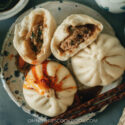
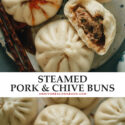
Thank you so much for posting this recipe! It’s exactly what me and my sister were looking for, can’t wait to make them 😛
Made this last night – we loved it! First time making buns so they were not pretty but your instructions and video were very helpful! However, I think the recipe has an error – the water amount is not correct. It says 150ml (2 cups + 2 tablespoons) … too much water! We just added another cup flour and had some big buns, but still delicious.
So sorry for the typo! 150 ml should be 1/2 cup + 2 tablespoons. I was calculating it in my mind and then totally typed it wrong.
I’m glad to hear your buns still came out well. Thanks for letting me know about this!
My buns were not as pretty as the ones in your pictures, but they sure were delicious! The smell and flavour brought me back to China, where I lived for some years. Great recipe!
Would love to try out this out. Is there a video for this recipe?
I haven’t had a chance to make one for this recipe but I do have an older steamed bun video if you’re curious about the wrapping method: http://youtu.be/dz-eu-yvsMU
I loved this on my first attempt but I think I can make them even better. Can I freeze the buns before the second rise?
For any yeast buns I prefer to freeze them after cooking because the freezing process might affect the dough rising. Unlike pizza dough (which you can freeze and it will rise later), the buns are tricky because the freezing process also release liquid from the filling which messes with the dough texture. I think you can try to freeze one if you made extra, but to be the safest, it’s the best to freeze the cooked buns.
I did this recipe with my sister and we totally loved it! It was amazing, thank you very much for sharing it! ❤️❤️❤️
Made it! Doable even for a complete novice such as I. Kneading dough is hard work though.